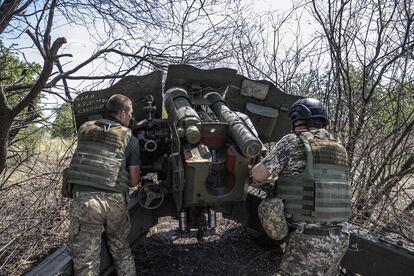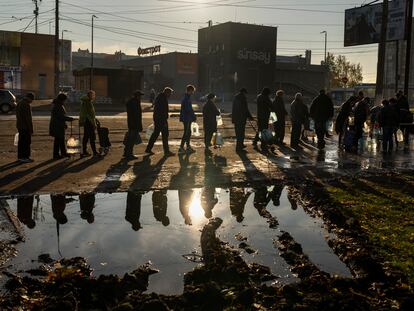Putin warns of global conflict as Russia conducts nuclear exercises
The Russian president repeated claims that Ukraine is planning to use a ‘dirty bomb’ while the West insists the Kremlin is using the supposed threat of such an attack as a pretext for a further escalation of the war

Russian President Vladimir Putin has reiterated that Moscow is aware Kyiv is preparing to use a dirty bomb - a conventional explosive laced with radioactive material that is released when the bomb detonates - despite both the Ukrainian authorities and the Western powers rejecting that accusation and stating their belief that the Kremlin is using the supposed threat of such an attack as a pretext for a further escalation of the war. During a meeting with the intelligence chiefs of the Commonwealth of Independent States on Wednesday, Putin also reportedly warned the risk of wider conflict in the region and the world remained high and as such recommended increasing security around key infrastructure sites.
Echoing the Russian leader’s words, Kremlin spokesman Dmitry Peskov said that Moscow would continue “vigorously” to pursue its accusations of Ukraine’s intent to deploy a dirty bomb in the conflict - something no regular army has ever done - with the international community and the United Nations.
Against the backdrop of Russia’s claims, Putin oversaw nuclear drills on Wednesday, the first time since the invasion of Ukraine was launched in February that Moscow has carried out a rehearsal for the scenario of a nuclear conflict. The Russian leader watched the maneuvers by strategic nuclear forces - which Defense Minister Sergei Shoigu told Putin were a dry run for “delivering a massive nuclear strike by strategic offensive forces in response to an enemy nuclear strike” - from a command center. Putin put Russia’s nuclear forces on high alert in March.
The exercises caused unease in Washington because, despite being a regular occurrence that both countries are alerted to beforehand, on this occasion the US was only informed by Russia the day before the maneuvers took place. “The tasks envisaged during the training of the strategic deterrence forces were completed in full, all missiles reached their targets,” the Kremlin said in a statement.
Among the weaponry tested by Moscow during the exercises were a Yars intercontinental ballistic missile, which was launched from the Kamchatka Peninsula in the Russian far east, and a Sineva ballistic missile fired from the Barents Sea. At least one nuclear submarine and two Tu-95 strategic bombers were deployed during the exercises.

Partial mobilization precursor to “all-out” attack on Ukraine
The Kremlin-installed authorities in the Donbas region have meanwhile stated that the partial mobilization ordered by Putin a month ago will serve as the basis for a general offensive against Ukraine in the coming months, even as Kyiv’s forces advance on the strategic city of Kherson. “The new reinforcements and reserves obtained by the partial mobilization, as well as the imposition of martial law and the military integration of the new territories, will be used to launch an all-out attack against the Ukrainian regime. That is why time is of the essence,” Rodion Miroshnik, ambassador for the Luhank People’s Republic in Moscow, told the Tass news agency.
“To this could be added the destruction of the energy system, communications and supply logistics, as a solid base for future victories over the NATO-maintained regime,” Miroshnik added.
Putin’s mobilization decree was issued on September 21 and is open-ended, giving no details of how many people have been mobilized or what the upper limit for conscription will be. The Russian Defense Ministry has stated that the goal is to add 300,000 civilians to the military’s ranks in Ukraine, but several independent media outlets, citing official sources, have suggested that the real figure Putin’s government is looking to enlist could stand at closer to one million. The Kremlin has denied these reports.
Tu suscripción se está usando en otro dispositivo
¿Quieres añadir otro usuario a tu suscripción?
Si continúas leyendo en este dispositivo, no se podrá leer en el otro.
FlechaTu suscripción se está usando en otro dispositivo y solo puedes acceder a EL PAÍS desde un dispositivo a la vez.
Si quieres compartir tu cuenta, cambia tu suscripción a la modalidad Premium, así podrás añadir otro usuario. Cada uno accederá con su propia cuenta de email, lo que os permitirá personalizar vuestra experiencia en EL PAÍS.
¿Tienes una suscripción de empresa? Accede aquí para contratar más cuentas.
En el caso de no saber quién está usando tu cuenta, te recomendamos cambiar tu contraseña aquí.
Si decides continuar compartiendo tu cuenta, este mensaje se mostrará en tu dispositivo y en el de la otra persona que está usando tu cuenta de forma indefinida, afectando a tu experiencia de lectura. Puedes consultar aquí los términos y condiciones de la suscripción digital.
More information

Russian troops preparing for urban combat in Kherson as Ukrainian army advances
Archived In
Últimas noticias
Most viewed
- Reinhard Genzel, Nobel laureate in physics: ‘One-minute videos will never give you the truth’
- Oona Chaplin: ‘I told James Cameron that I was living in a treehouse and starting a permaculture project with a friend’
- Pablo Escobar’s hippos: A serious environmental problem, 40 years on
- Why we lost the habit of sleeping in two segments and how that changed our sense of time
- Chevy Chase, the beloved comedian who was a monster off camera: ‘Not everyone hated him, just the people who’ve worked with him’









































